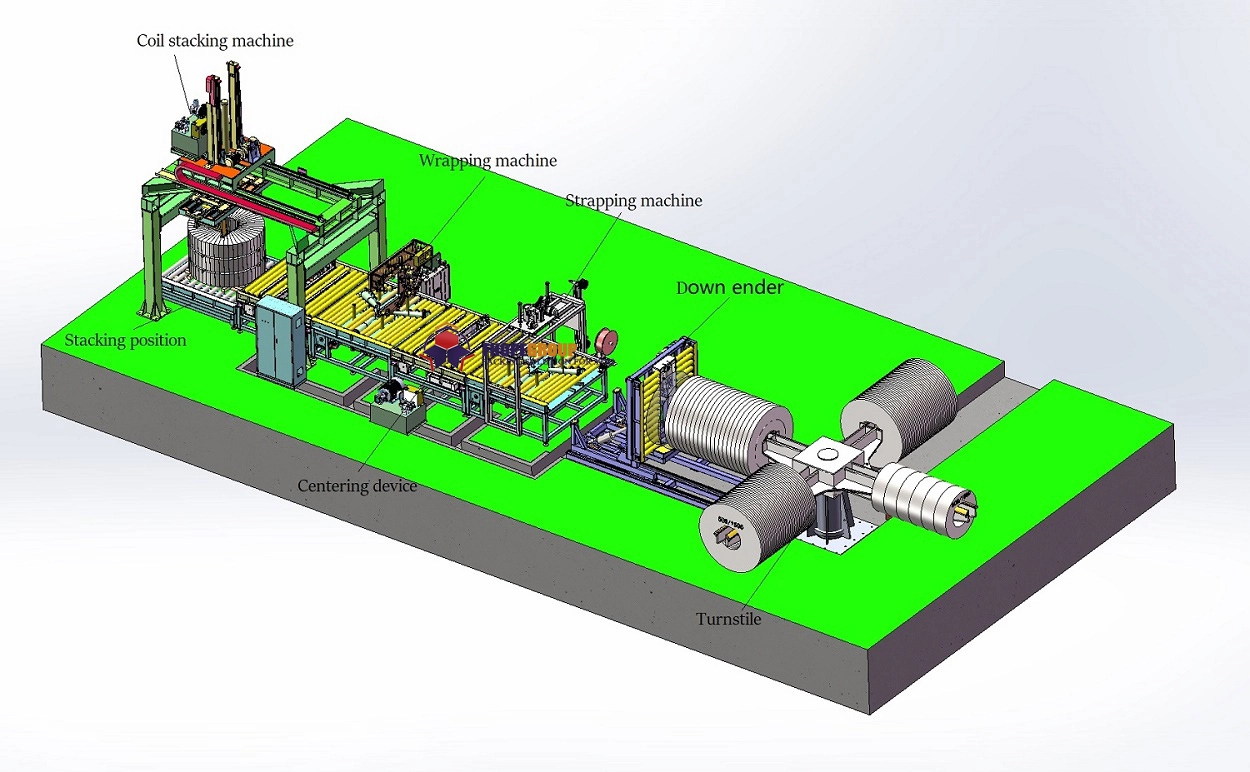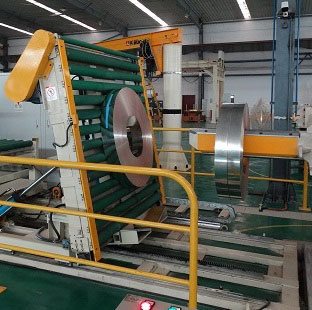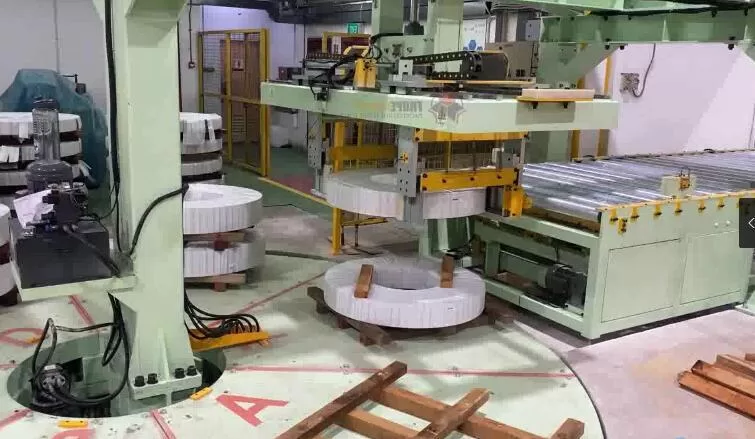Are you a factory manager in India's steel industry? If so, you probably feel constant pressure. You need to increase output, but your costs keep rising. Your current slit coil packaging line might be slow and rely too much on manual labor. This creates bottlenecks, slows down shipments, and even leads to worker injuries. You know there must be a better way, a way to cut costs without sacrificing quality or safety. But the thought of a huge investment with no guaranteed return is a major concern.
The best way for factory owners in India to cut costs on slit coil packaging lines is to shift from manual processes to strategic automation. This involves investing in reliable wrapping machines that reduce labor needs, using equipment that minimizes product damage during handling, and optimizing the consumption of packaging materials like stretch film. By focusing on the total cost of ownership instead of just the initial purchase price, factories can achieve significant long-term savings and a strong return on investment.

I understand this journey because I've walked it myself. Before I started SHJLPACK, I was an engineer on the factory floor. I saw the daily struggles firsthand. Later, when I built my own factory, I faced the same challenges you do. I learned that cutting costs is not about finding the cheapest machine. It's about building a smarter, more efficient process. It's about making a strategic investment that pays for itself over and over. Let's break down how you can do this for your own packaging line.
Is Automating Your Packaging Line the Best Way to Reduce Labor Costs?
You see your team manually wrapping heavy steel coils. It's slow, hard work. You know the wages, the cost of training, and the high turnover rate are a constant drain on your budget. When someone is injured or quits, your entire production schedule can be thrown into chaos. You worry that relying so much on manual labor is holding your factory back.
Yes, automating your packaging line is the most effective long-term strategy to reduce labor costs. An automated wrapping machine works faster and more consistently than any team of workers. It eliminates the direct costs of wages for manual packers and reduces the hidden costs associated with human error, injuries, and employee turnover. While it requires an initial investment, the increase in speed and efficiency leads to a clear and predictable return.

The True Cost of Manual Labor vs. Automation
Many factory managers only look at the upfront cost of a machine. They compare it to the monthly salary of a few workers and think it's too expensive. But this is a mistake. You have to look at the total cost. I learned this lesson the hard way in my own factory. We had a team of six people dedicated to wrapping coils. One Monday, two of them didn't show up. The entire shipping department fell behind. We almost lost a major client because of that delay. That's when I truly understood. An automated wrapper doesn't call in sick. It doesn't get tired. It doesn't make mistakes because it's distracted.
Let's break down the real comparison.
| Factor | Manual Packaging | Automated Packaging |
|---|---|---|
| Direct Labor Costs | High and recurring (wages, benefits) | Very low (operator to oversee) |
| Consistency | Varies by worker and time of day | Perfectly consistent, 24/7 |
| Speed (Throughput) | Low, limited by human speed | High, can be 2-3 times faster |
| Product Damage | Higher risk from improper handling | Minimal, controlled process |
| Worker Safety | High risk of back injuries, strains | Drastically improved, eliminates heavy lifting |
| Training Costs | Constant need to train new staff | One-time training for operators |
| Material Waste | High, inconsistent film usage | Low, optimized with pre-stretch systems |
The numbers on the table tell a clear story. The "cost" of manual labor isn't just wages. It's the cost of recruitment when someone leaves. It's the cost of production slowdowns. It's the cost of rejected products from inconsistent wrapping. And most importantly, it's the cost of a worker getting seriously injured. Automating your packaging line isn't about replacing your people. It's about moving them to safer, higher-value roles within your factory. It turns a major cost center into a predictable, efficient, and profitable part of your operation.
How Can You Minimize Product Damage During Coil Handling and Packaging?
Your team works hard to produce high-quality steel coils. But then, somewhere between the slitting line and the truck, damage happens. A forklift bumps a coil, or a manual wrap is too loose, and the edges get dented during transport. You receive a call from an angry customer. They reject the shipment. All that hard work, time, and material are wasted. This is not just a loss of profit; it's a loss of trust with your client.
You can minimize product damage by implementing a two-part solution: gentle, automated handling before packaging, and a precise, protective wrap during packaging. Using equipment like coil cars and turnstiles prevents dents and scrapes from manual movement. A quality wrapping machine then applies a uniform, tight wrap that secures the coil and protects its vulnerable edges from damage during shipping and storage.

Protecting Your Coils: A System, Not a Single Step
Thinking about damage control as just "better wrapping" is a common mistake. Damage often happens before the coil even reaches the wrapping station. The entire process, from the moment a coil comes off the slitter to the moment it's loaded onto a truck, needs to be secure. I often tell my clients that the last 50 meters of their production line are the most critical for their reputation.
Step 1: Automated and Gentle Handling
Manual handling is the biggest enemy of a perfect coil. A forklift operator might be in a hurry. A crane lift might be slightly off-center. These small moments lead to big problems. The solution is to remove as much of this manual interaction as possible.
- Coil Cars: These carts run on rails and move coils from the slitter to the packaging line smoothly and safely. No bumping, no dropping.
- Turnstiles: These devices receive coils and rotate them into the correct position for pickup or wrapping. This eliminates the need for forklifts to maneuver in tight spaces.
- Down-enders / Tilters: These machines safely tilt a coil from its eye-to-sky position to an eye-to-horizontal position (or vice-versa) for wrapping or stacking. This is a high-risk manual task that is easily and safely automated.
Step 2: Secure and Protective Packaging
Once the coil is safely at the station, the wrapping itself is your final layer of defense. A good orbital wrapper does more than just spin film around a coil.
- Uniform Tension: It applies the packaging material with consistent tension all the way around. This prevents loose spots that can lead to unraveling or shifting.
- Complete Coverage: It ensures the vulnerable edges and surfaces are fully covered. You can program the machine for the exact overlap you need.
- Correct Material Application: Whether you use VCI paper to prevent rust or heavy-duty stretch film for stability, the machine applies it correctly every time.
Here’s how to think about solving common damage issues:
| Common Damage Point | Manual Process Risk | Automated Solution |
|---|---|---|
| Coil Edges | Dented by forklift tines or dropped | Gentle handling with coil cars; Full protective wrap by machine. |
| Coil Surface | Scratched by chains or improper storage | Smooth transfer systems; Cocoon wrap provides a protective layer. |
| Telescoping | Loose inner wraps from inconsistent hand wrapping | A tight, uniform wrap from an orbital wrapper holds layers together. |
By building a system that handles your product gently and wraps it securely, you are not just saving money on damaged goods. You are building a reputation for quality and reliability that will win you more business in the long run.
What Should You Look for in a Packaging Machine to Ensure a High ROI?
You've decided to invest in a machine. But the market is full of options. Some suppliers promise very low prices, which seems tempting. But you've been burned before. You bought a machine that looked good on paper, but it broke down constantly, and getting service was a nightmare. You are rightly cautious. You know the real goal is not to buy the cheapest machine, but to make the smartest investment that delivers a strong Return on Investment (ROI).
To ensure a high ROI, you must look beyond the initial price tag and evaluate the machine's Total Cost of Ownership (TCO). This means prioritizing a durable, heavy-duty build for reliability, looking for features like a film pre-stretch unit to reduce material costs, and confirming that the supplier provides excellent after-sales support and spare parts availability. A machine that runs reliably with low operating costs will deliver a much better ROI than a cheap machine that causes constant downtime.

Beyond the Price Tag: Calculating Your True Return
When I started my own factory, my budget was tight. The temptation to buy the cheapest equipment was huge. But my experience as an engineer taught me that breakdowns are the most expensive part of any operation. A stopped production line costs you money every single minute. So, I chose to invest in machines that were built to last, even if they cost a bit more upfront. It was one of the best decisions I ever made.
A machine's true value is tied to its ROI, which is driven by its TCO. Let's look at the key features that directly impact your bottom line.
Key Features That Drive ROI
Don't get distracted by fancy bells and whistles. Focus on the core engineering and features that save you money or make you money every single day.
| Feature | How It Impacts Your ROI |
|---|---|
| Heavy-Duty Construction | Uses strong steel frames and quality components. This means fewer breakdowns, less downtime, and a much longer machine life. Your uptime directly equals profit. |
| Film Pre-Stretch Unit | Stretches the film before application, often by 200-300%. This can cut your film consumption by 50% or more. This is a direct, measurable saving every day. |
| Reliable Brand Components | Uses motors, sensors, and PLCs from well-known brands (like Siemens, Schneider, Omron). This ensures reliability and makes it easier to find spare parts if needed. |
| Ease of Maintenance | Designed with easy access to moving parts. This means your team can perform routine maintenance quickly, reducing downtime. |
| Strong After-Sales Support | The supplier provides installation, training, and has a clear process for technical support and spare parts. This is your insurance against long shutdowns. |
When you talk to a potential supplier, ask them these questions:
- What brand are the motors and electronics?
- Can you show me the pre-stretch system and explain the film savings?
- What is your process for providing technical support if I have a problem?
- How quickly can I get critical spare parts?
A supplier who is hesitant to answer these questions is focused on a quick sale. A true partner, like we strive to be at SHJLPACK, is focused on your long-term success. We know that our success is built on your factory running smoothly and profitably. A high ROI comes from a machine that works hard for you, day in and day out, for years to come.
Why is an Integrated "Total Solution" Better Than Buying Standalone Machines?
Many factory owners take a piecemeal approach. They buy a conveyor from one supplier, a wrapping machine from another, and a stacking unit from a third, often based on who has the lowest price for each item. This seems logical, but it often creates a "Frankenstein" production line where nothing works together smoothly. You end up with bottlenecks, communication errors between machines, and a major headache when something goes wrong because each supplier blames the others.
An integrated "total solution" from a single, expert source is far better because it guarantees every component works together in harmony. The conveyors, wrappers, and stackers are designed as a unified system, eliminating bottlenecks and optimizing workflow. This approach simplifies installation, operation, and maintenance, and gives you one point of contact for all service and support, ensuring accountability and maximizing your line's overall efficiency.

The Power of a Unified System
I've visited hundreds of factories in my career. The most efficient ones always have one thing in common: their production lines flow. There are no awkward gaps, no manual interventions between automated steps, and no "traffic jams" of products waiting for the next machine. This is the power of an integrated solution. It's the difference between a collection of machines and a true production system.
Let's look at the problems with a piecemeal approach versus the benefits of a total solution.
The Pitfalls of a "Frankenstein" Packaging Line
- Mismatched Speeds: Your wrapper can handle 60 coils per hour, but your conveyor can only feed it 40. You've created a permanent bottleneck.
- Communication Gaps: The machines don't "talk" to each other. A sensor on one machine doesn't trigger the right action on the next, leading to jams or stops.
- The Blame Game: When the line stops, who do you call? The conveyor supplier blames the wrapper supplier, and the wrapper supplier blames the control system integrator. You are stuck in the middle with a line that isn't working.
- Wasted Floor Space: Awkward connections and standalone units often take up more space than a streamlined, integrated line.
The Benefits of a SHJLPACK "Total Solution"
Our slogan is "TOTAL SOLUTION FOR WRAPPING MACHINE" for a reason. We learned early on that our customers' success depends on the entire process, not just one machine.
- Seamless Flow: We design the entire line—from the coil car that picks up the slit coil to the wrapping machine to the final stacking and palletizing unit—to work as one. The speed and timing of each component are perfectly synchronized.
- One Control System: Your operator can manage the entire line from a single, user-friendly HMI panel. It simplifies operation, reduces training time, and provides better data on your overall performance.
- Single Point of Accountability: If you ever have an issue, you make one phone call. To us. We designed it, we built it, we installed it, and we stand behind it. There is no blame game. There is only a solution.
- Optimized for You: We don't sell you a box. We analyze your specific coil sizes, your required throughput, and your factory layout. We then design a solution that is tailor-made to meet your goals.
I once worked with a client, a manager named Michael, who had this exact problem. He bought a top-of-the-line wrapper but tried to save money with a cheap conveyor. The machines were constantly out of sync. We came in and designed a simple connecting section with sensors that acted as the "brain" between the two. That small change unlocked the full capacity of his expensive wrapper. It showed me that the value is in the system, not just the individual parts.
Conclusion
Cutting costs on your coil packaging line is about smart automation, protecting your product, and choosing a partner who provides a total, integrated solution for long-term success.




